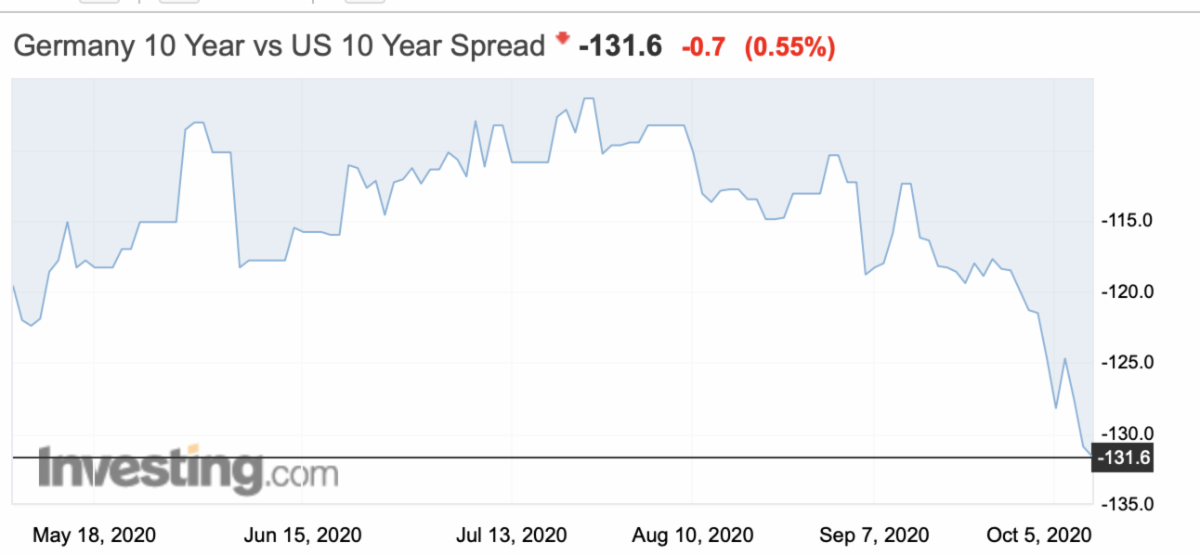The euro finally broke down on Tuesday as it experienced its strongest one-day slide in three weeks against the U.S. dollar. We have been calling for a sell-off for days now as the rise in new coronavirus cases pose a major risk to the region’s outlook. France, Germany and Spain all reported significant spikes in cases, which we believed would cause significant concern for investors and central bankers. We finally saw evidence of that today with the steep decline in the Eurozone and German ZEW surveys. The German index fell from 77.4 to 56.1 as the “recent sharp rise in COVID-19 cases increased uncertainty about the future economic outlook,” according ZEW President Achim Wambach. Today, ECB member Klaas Knot also said growth in Europe seems to be slowing. There’s no question that the region’s outlook is deteriorating quickly and, with risk appetite turning negative due to vaccine and stimulus snags, the path of least resistance for the euro is lower. Minimally, we are looking for a test of 1.16, but a steeper decline is possible for the following reasons:
1. Second Virus Wave Spreading Across Europe
New coronavirus cases are exploding in Europe raising concerns that the region could return to the tough times experienced at the start of the year. Daily infections hit a record high of 26,896 over the weekend in France and are hovering above 10,000 a day in Spain. To put this into perspective, back in March, cases in France peaked at 7,578 and in Spain at 9,159. Even Germany reported more than 4,000 cases. Countries across Europe have imposed new restrictions and more is likely to follow. No matter how you look at it, the Eurozone economy will be hit hard by the second wave.
2. Partial Lockdowns Could Mean Double-Dip Recession
These partial lockdowns will kill the Eurozone’s recovery. During the summer, economists predicted a second-half recovery for the region. Now, it will be lucky if they can escape a double-dip recession. We are just beginning to see deterioration in Eurozone data but next month, when the October numbers are released, we’ll learn just how damaging these new restrictions were for the economies. In the second quarter, Eurozone GDP contracted 11.8%. We may not see double-digit declines this time around since governments are trying to avoid full lockdowns, but there’s a very good chance of a contraction in the fourth quarter. The impact on the euro could be significant. Back in March, the single currency dropped from a high of 1.15 to a low of 1.0637 in a matter of weeks. There was also tremendous volatility as investors took stock of the damage to the economy.
3. More ECB Easing
Unless Eurozone nations suddenly get these outbreaks under control, it is widely believed that the European Central Bank will need to increase its Pandemic Emergency Purchase Program at the end of the year. On the basis of inflation alone, which hit a record low in September, more easing is needed to meet its mandate. However, now that the second-half recovery is at risk, the central bank will have no choice but to provide additional support to the economy. An interest rate cut is also on the table, but it's seen as less effective than expanding or extending PEPP. Last week, ECB President Christine Lagarde said they are “prepared to use all the tools that will produce the most effective, efficient and proportionate outcome” if the economy deteriorates further.
4. U.S. Election Uncertainty
U.S. election uncertainty could also drive investors out of risk currencies like the euro. Risk appetite and the rally in stocks are the only reasons why the euro refuses to fall. Every positive U.S. stimulus headline lifted the currency, but as the election nears, so does the uncertainty. President Donald Trump wants to tout a stimulus package or a smaller relief bill before the election, but House Speaker Nancy Pelosi feels their proposal falls grossly short. Trump may not get his pre-election vaccine either after Johnson & Johnson paused its vaccine trial due to unexplained illness and Eli Lily suspended its antibody trials over safety concerns. Between negative euro and U.S. news flow, further profit-taking is likely in euro.
5. German-U.S. Bond Yield Spread Widest Since March
Lastly, the German-U.S. 10-year yield spread hit its widest level since March. This is a reflection of all the issues we’ve talked about. Bond traders expect more ECB stimulus and the central bank is likely to deliver before the end of the year. Currencies take their cue from bonds and it was only a matter of time before the euro followed the yield spread lower.

